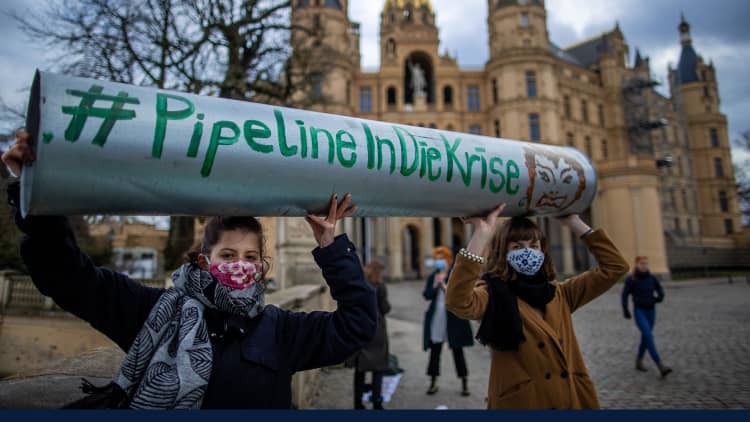Climate scientists described the shocking images of gas spewing to the surface of the Baltic Sea as a “reckless release” of greenhouse gas emissions that, if deliberate, “amounts to an environmental crime.”
Anadolu Agency | Anadolu Agency | Getty Images
Two subsea pipelines connecting Russia to Germany are at the center of international intrigue after a series of blasts caused what might be the single largest release of methane in history — and many suspect it was the result of an attack.
An initial crime scene investigation last week into what caused the gas leaks on the Nord Stream 1 and 2 pipelines reinforced suspicions of “gross sabotage.”
As investigations continue, many in Europe suspect the incident was the result of an attack, particularly as it occurred during a bitter energy standoff between the European Union and Russia.
The Kremlin has repeatedly dismissed claims it destroyed the pipelines, calling such allegations “stupid” and “absurd,” and claiming that it is the U.S. that had the most to gain from the gas leaks.
The White House has denied any involvement in the suspected attack.
What happened?
On Sept. 26, a flurry of detonations on two underwater pipelines connecting Russia to Germany sent gas spewing to the surface of the Baltic Sea. The explosions triggered four gas leaks at four locations — two in Denmark’s exclusive economic zone and two in Sweden’s exclusive economic zone.
The magnitude of those explosions was measured at 2.3 and 2.1 on the Richter scale, respectively, Swedish and Danish authorities said, and likely corresponded to an explosive load of “several hundred kilos.”
Neither of the Nord Stream pipelines was transporting gas at the time of the blasts, although they both contained pressurized methane — a potent greenhouse gas.
Remarkably, the signature of the gas bubbling at the surface of the Baltic Sea could be seen from space.
A satellite image of the Nord Stream leak in the Baltic Sea, captured on Sept. 26, 2022.
Planet
Climate scientists described the shocking images of the methane erupting from the burst as a “reckless release” of greenhouse gas emissions that, if deliberate, “amounts to an environmental crime.”
At the time, Denmark’s armed forces said video footage showed the largest gas leak created a surface disturbance of roughly 1 kilometer (0.62 miles) in diameter, while the smallest leak caused a circle of approximately 200 meters.
The Nord Stream gas pipelines have become a focal point of tensions between Russia and Europe in recent months, with Moscow accused of weaponizing gas supplies in a bid to gain sanctions relief amid its onslaught in Ukraine.
Who’s to blame?
Sweden’s national security service said Thursday that detonations caused “extensive damage” to the pipelines and “strengthened suspicions of gross sabotage.”
Sweden’s Security Service said certain seizures had been made, without offering further details, and that these would now be reviewed and analyzed.
“The continued preliminary investigation must show whether someone can be served with suspicion and later prosecuted,” Sweden’s Security Service said.
Sweden’s prosecutor’s office said in a separate statement that the area was no longer cordoned off.
The European Union has warned that any deliberate attack on European energy infrastructure would be met with the “strongest possible response,” calling what it suspects is an intentional attack “utterly unacceptable.”
Most Western governments have stopped short of pointing the finger directly at Russia, while the Kremlin has sought to pin the blame on the West.
U.S. President Joe Biden described the blasts on the Nord Stream pipelines as a “deliberate act of sabotage” late last month, saying Washington was working with its allies to work out exactly what happened.
Fatih Birol, the executive director of the International Energy Agency, said at a conference in Paris last month that it was “very obvious” who was responsible for the gas leaks, Reuters reported. He did not say who that was, however.
Russia has denied it was responsible for the gas leaks. Russian Foreign Ministry spokesperson Maria Zakharova said at a briefing on Thursday that such claims were “absurd,” according to Tass news agency.
Zakharova emphasized the “enormous investment” that the Kremlin took in the infrastructure project and lashed out at the West for blocking Moscow from taking part in the investigations.
Environmental impact
The unexplained Nord Stream gas leaks pose serious questions about the incident’s environmental impact.
Climate scientists acknowledged in the aftermath of the event that it was hard to accurately quantify the exact size of the emissions and said the leaks are a “wee bubble in the ocean” compared with the massive amounts of methane emitted around the world every day.
Methane is 84 times more potent than carbon and doesn’t last as long in the atmosphere before it breaks down. That makes it a critical target for combatting climate change quickly while simultaneously minimizing other greenhouse gas emissions.
“It was a deliberate act and in my opinion it can very likely be linked to the push for constant provocation by the Kremlin,” Spanish Energy Minister Teresa Ribera told reporters last month, according to Reuters.
Europa Press News | Europa Press | Getty Images
The two Nord Stream pipelines were estimated to have contained enough gas to release 300,000 tons of methane — more than twice the amount released by the 2015 Aliso Canyon leak in California, the largest known release of methane in U.S. history.
While that means it could be one of the largest single releases of methane, the incident pales in comparison with the roughly 70 million tons of methane emitted by the oil and gas industry each year.
The European Space Agency estimated that the emissions leak from the Nord Stream gas pipelines was roughly equivalent to one and a half days of global methane emissions.
Nonetheless, environmental campaigners argued the incident serves as yet another reminder of the risks associated with fossil fuel infrastructure.
— CNBC’s Emma Newburger contributed to this report.







